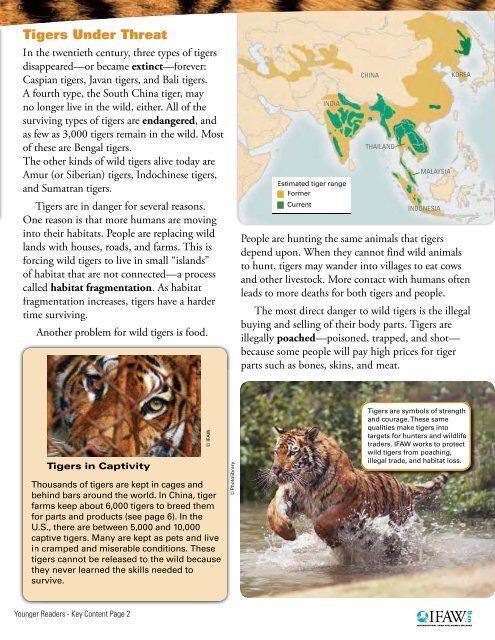Born to Be Wild - International Fund for Animal Welfare
Born to Be Wild - International Fund for Animal Welfare
Born to Be Wild - International Fund for Animal Welfare
You also want an ePaper? Increase the reach of your titles
YUMPU automatically turns print PDFs into web optimized ePapers that Google loves.
Tigers Under Threat<br />
In the twentieth century, three types of tigers<br />
disappeared—or became extinct—<strong>for</strong>ever: t<br />
Caspian tigers, Javan tigers, and Bali tigers.<br />
A fourth type, the South China tiger, may<br />
no longer live in the wild, either. All of the<br />
surviving types of tigers are endangered, and<br />
as few as 3,000 tigers remain in the wild. Most<br />
of these are <strong>Be</strong>ngal tigers.<br />
The other kinds of wild tigers alive <strong>to</strong>day are<br />
Amur (or Siberian) tigers, Indochinese tigers,<br />
and Sumatran tigers.<br />
Tigers are in danger <strong>for</strong> several reasons.<br />
One reason is that more humans are moving<br />
in<strong>to</strong> their habitats. People are replacing wild<br />
lands with houses, roads, and farms. This is<br />
<strong>for</strong>cing wild tigers <strong>to</strong> live in small “islands”<br />
of habitat that are not connected—a process<br />
called habitat fragmentation. As habitat<br />
fragmentation increases, tigers have a harder<br />
time surviving.<br />
Another problem <strong>for</strong> wild tigers is food.<br />
Tigers in Captivity<br />
Thousands of tigers are kept in cages and<br />
behind bars around the world. In China, tiger<br />
farms keep about 6,000 tigers <strong>to</strong> breed them<br />
<strong>for</strong> parts and products (see page 6). In the<br />
U.S., there are between 5,000 and 10,000<br />
captive tigers. Many are kept as pets and live<br />
in cramped and miserable conditions. These<br />
tigers cannot be released <strong>to</strong> the wild because<br />
they never learned the skills needed <strong>to</strong><br />
survive.<br />
Younger Readers - Key Content Page 2<br />
© IFAW<br />
© Pho<strong>to</strong>library y<br />
INDIA<br />
Estimated tiger range<br />
Former<br />
Current<br />
CHINA<br />
THAILAND<br />
MALAYSIA<br />
INDONESIA<br />
KOREA<br />
People are hunting the same animals that tigers<br />
depend upon. When they cannot find wild animals<br />
<strong>to</strong> hunt, tigers may wander in<strong>to</strong> villages <strong>to</strong> eat cows<br />
and other lives<strong>to</strong>ck. More contact with humans often<br />
leads <strong>to</strong> more deaths <strong>for</strong> both tigers and people.<br />
The most direct danger <strong>to</strong> wild tigers is the illegal<br />
buying and selling of their body parts. Tigers are<br />
illegally poached—poisoned, d trapped, and shot—<br />
because some people will pay high prices <strong>for</strong> tiger<br />
parts such as bones, skins, and meat.<br />
Tigers are symbols of strength<br />
and courage. These same<br />
qualities make tigers in<strong>to</strong><br />
targets <strong>for</strong> hunters and wildlife<br />
traders. IFAW works <strong>to</strong> protect<br />
wild tigers from poaching,<br />
illegal trade, and habitat loss.

















